CarEdge saved me over 4,500 dollars on a brand new Honda Pilot. I can't say thank you enough.
Price intelligence
Find a wide range of vehicle listings with market insights on new and used listings near you.


Help us personalize your CarEdge experience — it only takes a second.
Your answers help us personalize your CarEdge journey — we’ll follow up with tips and next steps that match your buying timeline.

Florida Governor Ron DeSantis has approved a bill partially banning direct-to-consumer car sales in the state, a move set to make the most pro-dealer state even more of a car dealer’s paradise. The legislation, heavily influenced by the Florida Automobile Dealers Association (FADA), also imposes restrictions on automakers, limiting their ability to penalize dealers who choose to mark up car prices. The new Florida law is being lauded by car dealer associations. Make no mistake: House Bill 637 is bad news for consumers, no matter how you look at it.
The Florida dealer lobby played an instrumental role in drafting and pushing through the bill (HB 637). For dealers, their efforts have paid off. The legislation mandates that traditional automakers must sell their vehicles through approved dealers, reinforcing the conventional car sales model and curbing the growing trend of direct-to-consumer sales.
However, the law includes a specific exception for electric vehicle giant Tesla. Tesla was the first to find success with its direct-to-consumer model. By including an exception for automakers who have never sold via a dealership model, Florida is steering clear of a clash with the #1 EV seller. This exception could potentially pave the way for other electric vehicle brands like Lucid and Rivian to continue their direct-to-consumer sales in the Sunshine State.
FADA President, Ted Smith, addressed this carve-out. “We made a clear delineation between a manufacturer that has never had dealers and maybe never will, and those who have been heavily dependent upon their dealerships to be their marketing and sales presence in Florida.”
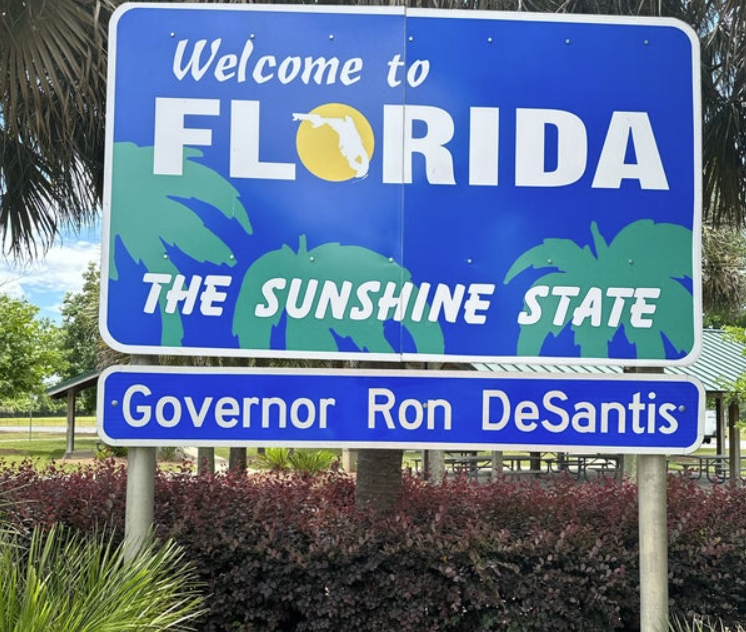
Another part of the bill allows dealers to set their own prices without adhering to the manufacturer’s suggested retail price (MSRP). The new law prohibits automakers from penalizing dealers for markups. The bill also explicitly restricts automakers from limiting allocation to dealers who impose markups. Equally, automakers are prevented from rewarding dealers who choose to sell at or below MSRP.
But wait, there’s more. The bill states that manufacturers must pay dealers eight percent of the revenue from any post-purchase electronic vehicle upgrades or activations sold within the first two years of purchase. This includes both one-time and subscription-based upgrades, potentially pushing prices higher for these additional services. Evidently, car buyers will have even more reasons to reconsider subscriptions for heated seats or over-the-air updates for acceleration boosts.

These changes highlight the huge influence of dealer lobbies in the United States. In the most recent election cycle, 85.5% of U.S. Representatives and 57 Senators received campaign contributions from auto dealers. This influence is so great that even the Consumer Financial protection Bureau (CFPB), established in 2011 to protect consumer interests, has a provision prohibiting the agency from directly monitoring dealerships.
Ultimately, the landscape of car buying continues to evolve, with power plays between manufacturers, dealers, and legislators. At CarEdge, we’re committed to helping you navigate car buying to find the best deals.
Browse cars with behind-the-scenes market data with CarEdge Car Search. Ready to unlock the full suite of data for a car you’re serious about? CarEdge Report is your one-stop shop for deal analysis. Get 1:1 expert guidance as you learn how to negotiate the BEST deal with CarEdge Coach.
Stay tuned as we continue to monitor the impact of this new Florida Law on car buyers in Florida and potentially beyond.

The current landscape of the car market is an intricate maze of fluctuating inventory levels and shifting price tags. Your guiding light through this labyrinth? Knowledge, of course. The knowledge that shines the brightest is the understanding of Market Day Supply (MDS). This illuminates the number of days it would take to sell all the inventory of a particular model, assuming no new cars enter the market and the current sales rate holds steady. A high MDS suggests a surplus that may give you, the buyer, some bargaining leverage. In contrast, a low MDS may indicate the sellers have the upper hand.
By exploring CarEdge Data, we’ve highlighted which new cars in 2023 have the best and worst reliability ratings, and what the inventory data tells us about them. We think you’ll agree that these insights are rather fascinating, and provide you with the knowledge to navigate the market like a pro.

Using CarEdge Data, we analyzed nationwide supply and sales data for the ten most reliable cars in America, according to Consumer Reports. Here’s the data, and what it means for buyers.
| CR Reliability Ranking | Make | Model | Starting Price | Market Day Supply | Total For Sale | Total Sold (45 Days) |
|---|---|---|---|---|---|---|
| 1 | Toyota | Corolla Hybrid* | $24,145 | 24 | 11887 | 22588 |
| 2 | Lexus | GX | $59,775 | 56 | 3358 | 2679 |
| 3 | MINI | Hardtop 2 Door and 4 Door | $26,795 | 95 | 2809 | 1329 |
| 4 | Toyota | Prius | $28,445 | 23 | 1314 | 2574 |
| 5 | Mazda | MX-5 Miata | $29,215 | 85 | 1184 | 631 |
| 6 | Lincoln | Corsair | $40,085 | 96 | 3315 | 1550 |
| 7 | Toyota | Corolla* | $22,795 | 24 | 11887 | 22588 |
| 8 | Subaru | Crosstrek | $26,290 | 18 | 238 | 598 |
| 9 | BMW | 3 Series | $44,795 | 67 | 2642 | 1778 |
| 10 | Toyota | Prius Prime | $33,345 | 43 | 630 | 664 |
Firstly, the reliability leaderboard has a strong Toyota presence. Models like the Toyota Corolla Hybrid, Toyota Prius, and Toyota Corolla claim high reliability ratings from Consumer Reports. These models fly off the dealer lots relatively quickly with a Market Day Supply of just 23-24 days, showing the high demand for reliable Toyota cars. Data was unavailable for the Corolla Hybrid, so we have included the latest numbers for the overall Corolla model. These popular, reliable cars will be less negotiable due to higher demand and quicker sell times.
CarEdge’s Ray Shefska made it clear that despite great reliability and high demand, the days of being forced into paying a dealer markup are long gone. “No matter what the dealer tells you, never pay a markup or so-called ‘market adjustment’ for a new Toyota. The car market is very different in 2023 compared to the madness we saw during the chip shortage.”
Next, the MINI Hardtop (2 Door and 4 Door) and Lincoln Corsair, despite their high reliability, have a much longer MDS (95 and 96, respectively), suggesting these reliable models may not be as in-demand. You’ll have more leverage negotiating these prices, especially with industry knowledge and familiarity with how to work a deal.
The Subaru Crosstrek, another model with a high reliability rating, stands out with the lowest MDS among the top 10 reliable cars, indicating the supply can barely keep up with demand. CarEdge Car Coach Justise says that Subaru has been the low-inventory king for many years, and that’s not changing any time soon.
Looking at the price tags, the most reliable vehicles come with a broad range of starting prices, from $22,795 (Toyota Corolla) to $59,775 (Lexus GX). This proves that reliability isn’t necessarily associated with a steep price.
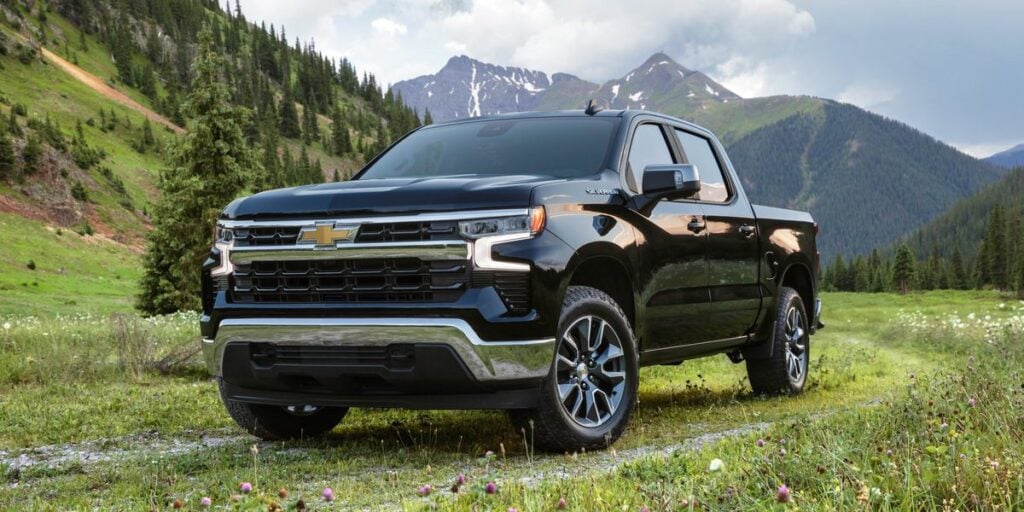
Car buyers aren’t racing to dealer lots for the models known for poor reliability. Unfortunately, American brands dominate the bottom ten.
| Make | Model | Starting Price | Market Day Supply | Total For Sale | Total Sold (45 Days) |
|---|---|---|---|---|---|
| Jeep | Wrangler | $36,990 | 98 | 26726 | 12330 |
| Mercedez-Benz | GLE | $58,850 | 69 | 5700 | 3733 |
| Jeep | Gladiator | $40,785 | 289 | 20945 | 3260 |
| Chevrolet | Silverado 1500 | $36,300 | 93 | 68320 | 33219 |
| GMC | Sierra 1500 | $37,100 | 121 | 30856 | 11477 |
| Chevrolet | Bolt | $27,495 | 35 | 3026 | 3908 |
| Ford | Explorer | $38,355 | 93 | 28323 | 13688 |
| Nissan | Sentra | $21,145 | 60 | 13381 | 10048 |
| Lincoln | Aviator | $54,735 | 178 | 4360 | 1103 |
| Hyundai | Kona Electric | $34,885 | n/a | n/a | n/a |
The Chevrolet Silverado 1500, despite its less than stellar reliability, has a significant volume on sale but a relatively high MDS. The takeaway? It’s plentiful but not necessarily popular.
Two other models, the Jeep Gladiator and Lincoln Aviator, despite their lower reliability, have very high MDS (289 and 178, respectively). It appears these models may be the wallflowers of the dealership lots.
Meanwhile, the Nissan Sentra holds its own despite lower reliability, with a fairly low MDS (60). Its budget-friendly starting price may be a contributing factor.
Interestingly, the Hyundai Kona Electric does not have available market or sales data, shedding little light on its demand or supply status.
As we can see, both highly reliable and less reliable cars come with a wide range of starting prices. This indicates that the cost is not necessarily a reliable indicator of its reliability.
Now, armed with these insights, you can navigate the market better. Whether you’re looking for a reliable titan like the Toyota Corolla, or even considering a less reliable model like the Chevrolet Silverado 1500, understanding the role of market days’ supply can give you the edge in your car-buying journey. Where there’s more inventory, greater negotiability is sure to follow.
Don’t forget to check out CarEdge Car Search, where auto industry insiders see behind-the-scenes data with every new and used car listing!
But we won’t leave you just yet. We want to arm you with more resources to make your journey smoother. One such tool is our free Car Buying Cheat Sheet. This popular resource can enhance your understanding of the market and help you zero in on the perfect car at the perfect price.
For a more detailed understanding, download your first CarEdge Report today. This report offers a comprehensive breakdown of key numbers in a simple and digestible format, setting you up for success at the negotiation table.
And if you’re looking for a personalized touch, CarEdge Coach is your ticket to savings. Our expert car buyers can offer personalized advice and help you negotiate thousands off your next car.
Don’t navigate the car market alone; let CarEdge steer you in the right direction. You’ll be thankful you did.
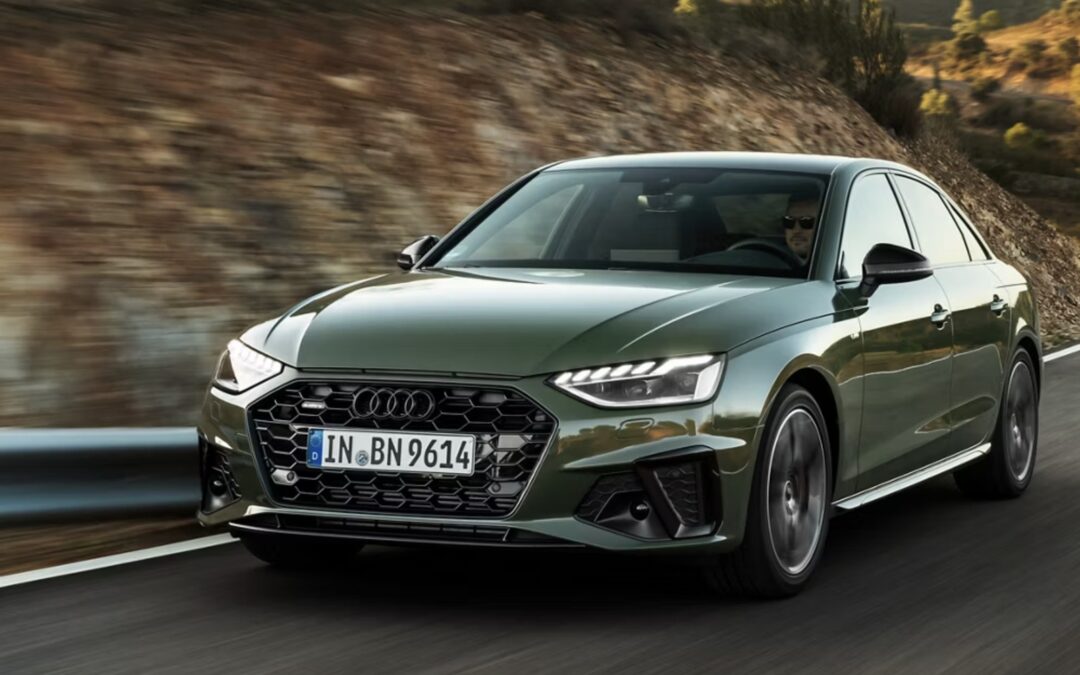
Navigating the current car market can be a daunting task, with its varying inventory levels and volatile prices. In this context, knowledge truly is power. A critical piece of this knowledge is understanding the Market Day Supply (MDS).
MDS is a measure of the number of days it would take to sell all of a particular model of car, based on the current sales rate, assuming no additional inventory is added. A high MDS suggests an oversupply, potentially giving buyers leverage for negotiation, while a low MDS might indicate a seller’s market, where negotiating could prove tougher.
Using CarEdge Pro, we identified which new cars have the most and least inventory available in December 2025.
Why does inventory matter to car buyers?
Inventory influences negotiability. When there’s a glut of cars, dealers will be more inclined to negotiate with you. Slim pickings? Not so much. This valuable insight can give you an edge in your car buying journey, helping you save money and avoid the hassle.
Here are the fastest and slowest-selling cars and trucks in America right now.
👉 Looking for SUVs, Trucks, or EVs? We’ve got it all.
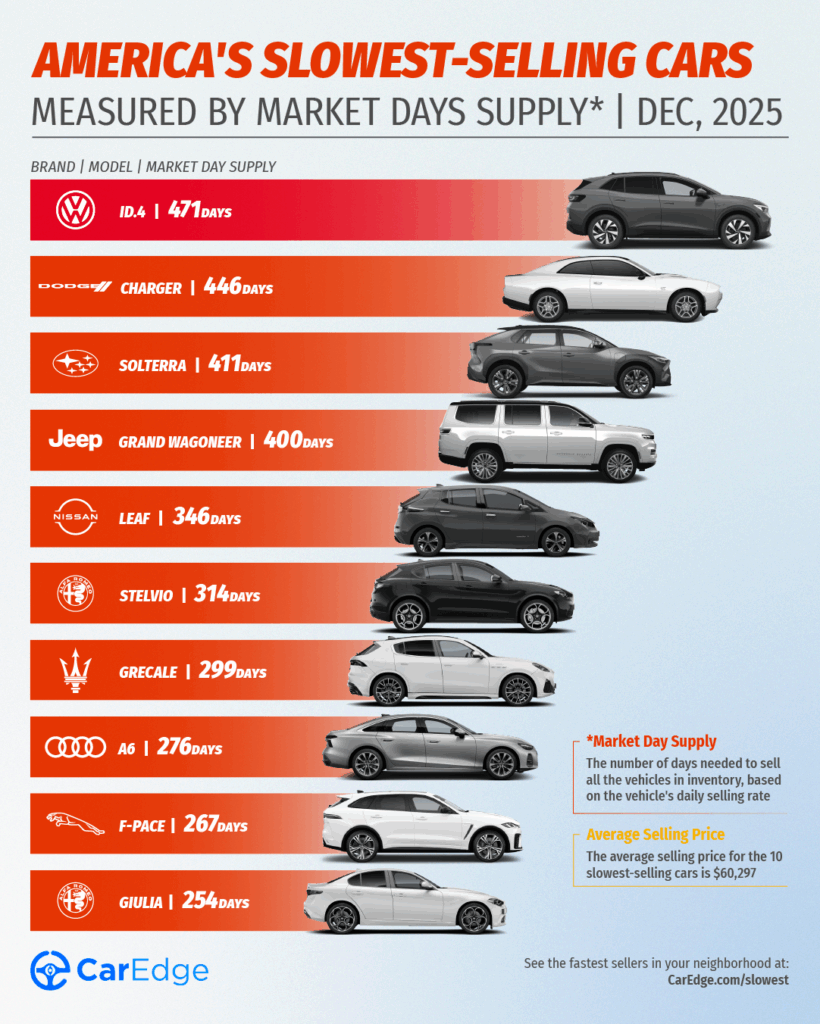
These are the slowest-selling cars in the U.S. right now. Following the expiration of the federal EV tax credit in September, sales of fully-electric vehicles have fallen off a cliff. In fact, the three slowest sellers are all EVs. At the top of the list, the Volkswagen ID.4 is the slowest-selling car in America in December 2025. Five Stellantis models are the top 10, a sharp increase from last month.
The average selling price for the 10 slowest-selling cars is $60,297 in December 2025.
Here are the 10 slowest-selling new cars, in other words, the models with the most inventory today.
| Make | Model | Market Day Supply | Total For Sale | 45-Day Sales | Average Selling Price |
|---|---|---|---|---|---|
| Volkswagen | ID.4 | 471 | 1,371 | 131 | $48,036 |
| Dodge | Charger | 446 | 2,588 | 261 | $56,936 |
| Subaru | Solterra | 411 | 868 | 95 | $41,463 |
| Jeep | Grand Wagoneer | 400 | 1,254 | 141 | $96,557 |
| Nissan | LEAF | 346 | 960 | 125 | $31,076 |
| Alfa Romeo | Stelvio | 314 | 886 | 127 | $57,297 |
| Maserati | Grecale | 299 | 672 | 101 | $82,381 |
| Audi | A6 | 276 | 2,467 | 402 | $64,960 |
| Jaguar | F-PACE | 267 | 2,136 | 360 | $70,204 |
| Alfa Romeo | Giulia | 254 | 554 | 98 | $54,057 |
There’s BIG potential for deals on any of these cars, but only with negotiation know-how.
👉 See local fastest and slowest sellers [free tool]
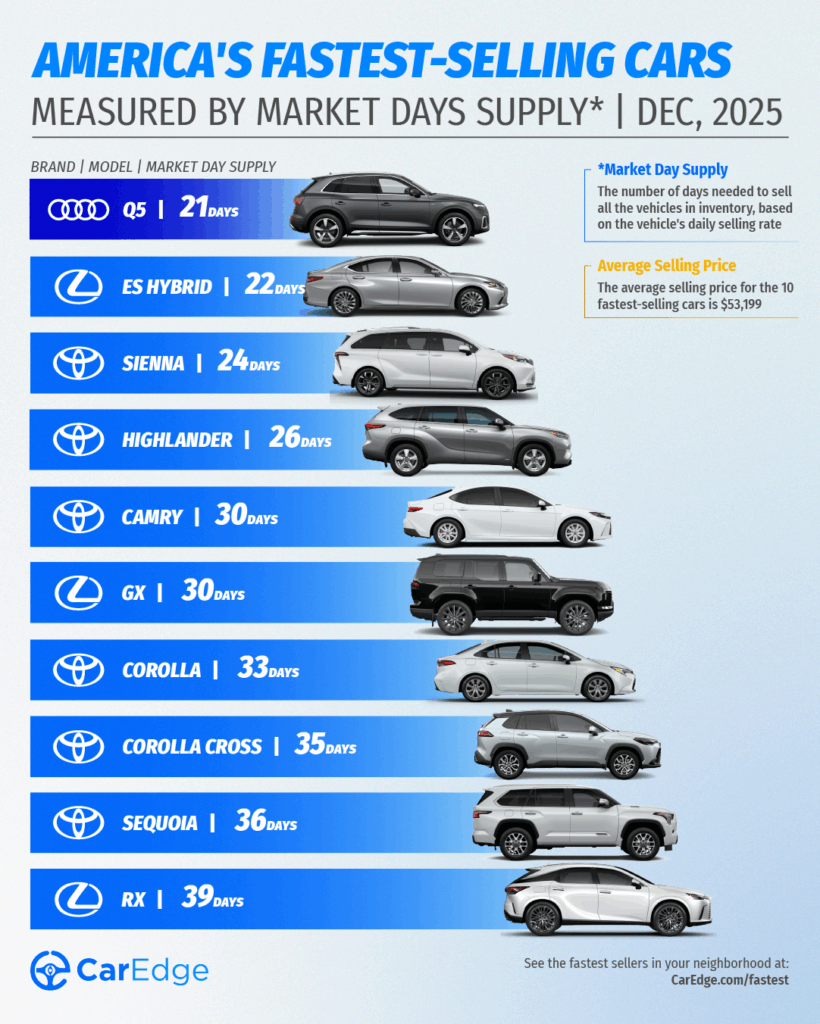
On the other side of the coin, these are the fastest-selling cars today. This month, all but one of the fastest-selling cars and SUVs are Toyota models. Audi’s Q5 has jumped into first place as buyer’s anticipate an incoming shipment of 2026 models. There are only 500 Q5s for sale nationwide currently.
Three Lexus models and six Toyota models occupy the rest of the top 10. The Toyota Sienna, Camry, Highlander, and Corolla are all quick sellers, and are the toughest to negotiate.
If you’re shopping for any of these new cars in 2025, you’ll be up against stiff competition. The average selling price for the 10 fastest-selling cars is $53,199.
Here are the fastest-selling cars in America right now:
| Make | Model | Market Day Supply | Total For Sale | 45-Day Sales | Average Selling Price |
|---|---|---|---|---|---|
| Audi | Q5 | 21 | 546 | 1,198 | $59,913 |
| Lexus | ES Hybrid | 22 | 701 | 1,410 | $52,166 |
| Toyota | Sienna | 24 | 8,769 | 16,221 | $51,910 |
| Toyota | Highlander | 26 | 5,408 | 9,238 | $52,294 |
| Toyota | Camry | 30 | 41,926 | 62,424 | $34,952 |
| Lexus | GX | 30 | 2,505 | 3,708 | $80,358 |
| Toyota | Corolla | 33 | 28,271 | 38,163 | $25,446 |
| Toyota | Corolla Cross | 35 | 15,932 | 20,331 | $31,303 |
| Toyota | Sequoia | 36 | 4,269 | 5,375 | $83,585 |
| Lexus | RX | 36 | 7,307 | 9,189 | $59,257 |
👉 See local fastest and slowest sellers [free tool]
Ready to outsmart the dealerships? Download your 100% free car buying cheat sheets today. From negotiating a deal to leasing a car the smart way, it’s all available for instant download.
👉 Know before you buy! Estimate your future insurance costs with our free car insurance calculator. We’re here to help!

Here’s a powerful and sobering statistic: In 2023, 30% of used cars have a price tag of under $20,000. Five years ago, 60% of used cars were below that price point. Where have all of the affordable used cars gone, and will they ever return to the market? We’ll take a look at the latest analysis from Edmunds, as well as the latest used car market data from CarEdge. Used car deals can still be had, if you know where to look, and how to negotiate.
The impact of the infamous chip shortage of 2021 and 2022 continues to be felt in the used car market. An astonishing 18 million new cars were never produced during this period, essentially erased from production schedules and not replaced. This production gap has created a ripple effect that will continue to influence the used car market for years to come, and this shift is just one of the significant changes the industry is undergoing.
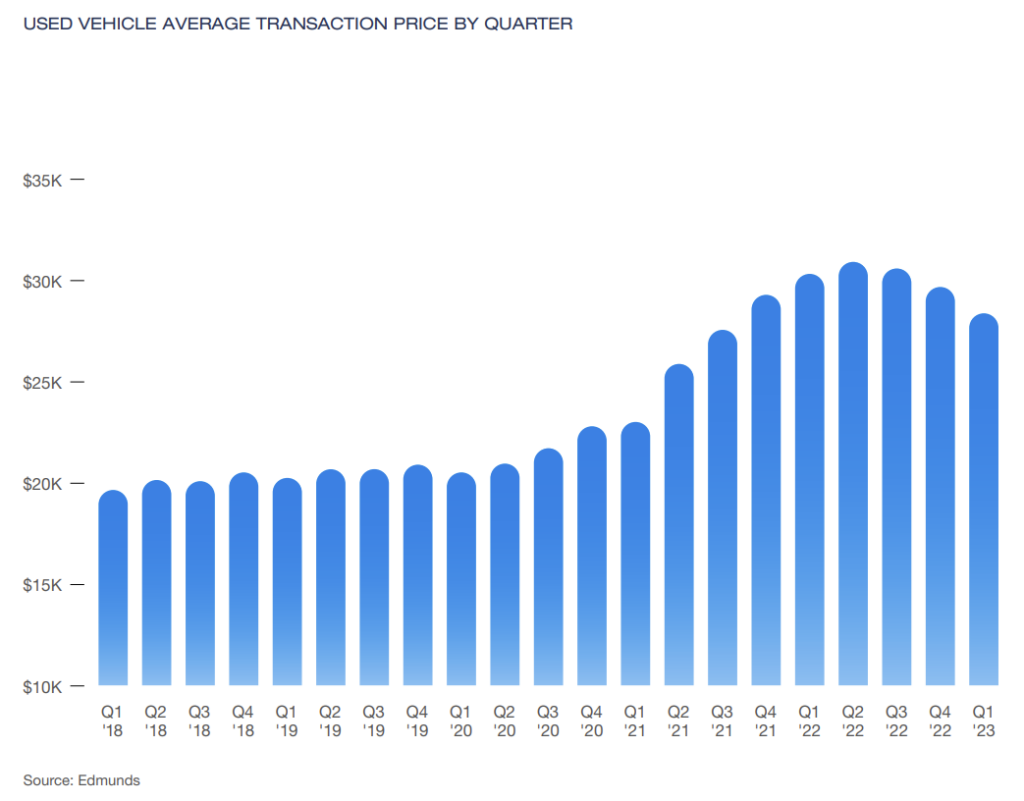
The latest data from Edmunds suggests that we might be facing a new normal rather than a temporary aberration. In terms of pricing, the average used car transaction price fell by 6.4% in the first quarter of 2023 compared to the same period last year. Sounds great, right? Not so fast. Used car prices are still a staggering 44% higher than the average back in 2018. To put it in perspective, the average selling price for a used car in America in Q1 2023 was $28,381, a far cry from the $19,657 average seen five years ago.
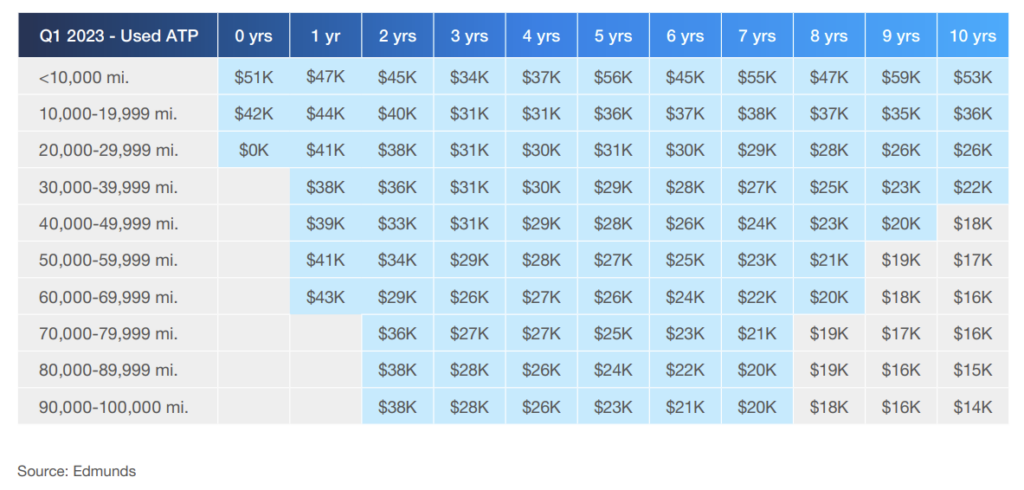
Used cars with a price tag of under $20,000 are hard to come by. The Edmunds data suggests that consumers have to look towards used cars that are at least 8 years old and have over 70,000 miles on the clock before they can find sub-$20,000 prices.
If you’re hoping for a used car that costs $15,000 or less, you’ll likely be considering vehicles that are a decade old or more. On top of that, there’s a huge mismatch in demand versus supply of cheap used cars. People want affordable transportation, but the new car market simply doesn’t offer it. The result is more competition for cheap used cars.
Older vehicles are seeing a surge in popularity despite their age. The reason is simple: they’re the only affordable cars around. Nearly half of all used cars sold today are older models priced under $25,000. In the new car market, a mere 5% of cars are sold for less than that price.
It’s more important than ever for consumers to understand car market trends and adjust their expectations (and budget) when setting out to purchase a used vehicle.
Our team recently launched a new 100% free tool, CarEdge Data Explorer. For the first time ever, local market data is available for every used car model, all in one spot. Using CarEdge Data Explorer, we analyzed used car listings in the five biggest used car markets in the nation: California, Texas, Florida, New York and Pennsylvania. By comparing market days’ supply, an important car market negotiability factor, our team of Car Coaches identified a troubling trend among the most popular age class, used cars that are three years old.
Why should you care about the days’ supply of used cars? Days supply in the car market is calculated by dividing the current unsold inventory of a specific car model by its average daily sale rate, which indicates how many days it would take to sell all the existing inventory at the current sales pace. For example, if there’s a 200 day supply of the 2019 Toyota Camry, that means it would take over six months to sell the existing inventory at current buying rates.
On the other hand, if you’re looking at a car with a 10, 20 or 30 day supply, all existing inventory is likely to be sold within the month. In other words, it’s in high demand. For reference, a typical days’ supply is about 60 days.
Here’s a subset of what we found in Data Explorer:
| Make | Model | Model Year | Days' Supply | Average Price |
|---|---|---|---|---|
| Toyota | Camry | 2020 | 49 | $26,043 |
| Toyota | Corolla | 2020 | 49 | $21,948 |
| Tesla | Model 3 | 2020 | 42 | $37,156 |
| Honda | Accord | 2020 | 53 | $27,103 |
| Nissan | Altima | 2020 | 65 | $22,436 |
| Toyota | RAV4 | 2020 | 56 | $31,471 |
| Honda | CR-V | 2020 | 64 | $29,453 |
| Tesla | Model Y | 2020 | 91 | $46,295 |
| Jeep | Grand Cherokee | 2020 | 86 | $34,133 |
| Toyota | Highlander | 2020 | 48 | $38,263 |
| Ford | F-150 | 2020 | 74 | $42,096 |
| Chevrolet | Silverado | 2020 | 70 | $41,349 |
| Ram | 1500 | 2020 | 83 | $42,181 |
| GMC | Sierra | 2020 | 74 | $46,486 |
| Toyota | Tacoma | 2020 | 68 | $36,680 |
The shortage of affordable used cars on the market is a severe issue that is negatively impacting consumers. High-demand vehicles in the lower price range have far less inventory available, making it increasingly difficult to find a reasonably priced used car, let alone negotiate for a better deal. This situation is the consequence of several economic and industry factors we’ve highlighted, with no quick fix in sight.
In contrast, the market for larger SUVs, and full-size trucks is relatively robust, but these come with a hefty price tag. Although this disparity in the market may provide a wider choice for those who can afford these more expensive models, it leaves budget-conscious consumers with limited options.
A graph of data from Data Explorer of the five top-selling cars, trucks and SUVs shows that lower prices mean less inventory:
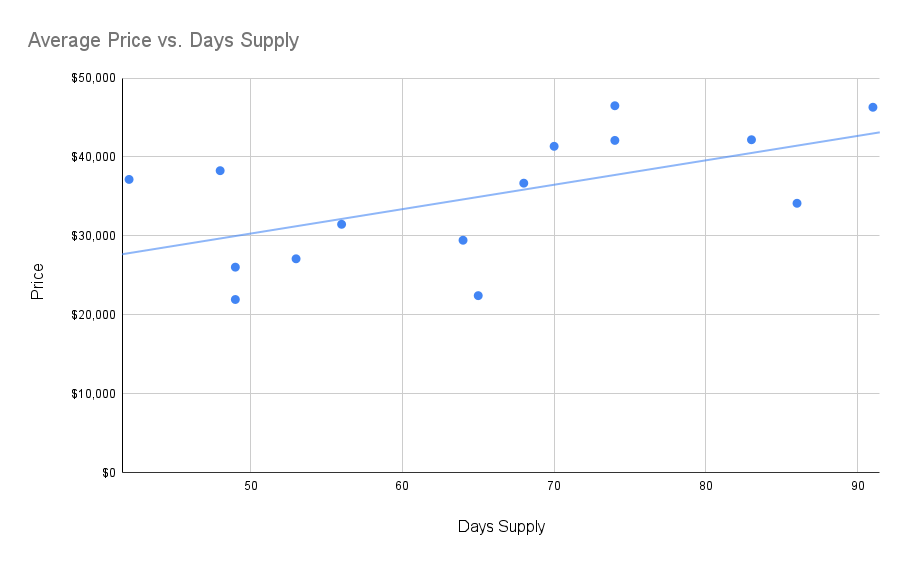
Affordable models are harder to come by today. While this reality poses a challenge for buyers, it also emphasizes the need for prospective car owners to be savvy, strategic, and armed with the best information possible to navigate this changing landscape.
We’re on a mission to bring car buyers everywhere more resources and tools to level the playing field when negotiating car deals. Do your own research using the same tools our team uses with CarEdge Data Explorer. See used car inventory in your area, average prices, average mileage and more in all 50 states. Data Explorer is your jumping off point for understanding current market trends. In the face of a challenging market, knowledge and strategy are your best allies in the hunt for an affordable used car.

You know what’s infuriating? The fact that dealers are increasingly shipping their most affordable used cars overseas. Yes, everyone should have access to transportation that’s at an attainable price point. That includes countries in Africa, Central America, and other regions where American used cars are heading. But let’s remember that supply is not meeting the demand for cheap used cars right here at home.
The global market for used light-duty vehicles grew by almost 20% between 2015 and 2019, resulting in over 4.8 million units being exported from the United States to developing countries. Following a slowdown during the pandemic, exports are skyrocketing in 2023.
Interestingly, the growing popularity of electric vehicles is contributing to an affordability crisis in the used car market. Dealers in states such as New York and Florida, where consumers are increasingly purchasing EVs, are turning to international markets to sell their older gas-powered models. Check out this intriguing piece by CNN to learn more about the lucrative international trade of used cars.
Firstly, a significant increase in the number of returned lease vehicles could lead to more affordable used cars. The volume of lease returns dropped from 6.2 million vehicles in 2018 to 5.5 million in 2022. Further, leasing has plummeted from 33% of the new car market in 2020 to only 17% today. This decline in leasing is starting to trickle down into the wider auto market, which affects the used car supply. For those nearing the end of their car lease, our guide spells out your options at the end of a lease.
Secondly, encouraging more trade-ins could help make used cars more affordable. Drivers nowadays are holding on to their cars for longer and being more judicious when it’s time to sell, often opting to sell to private buyers instead of dealerships. Increasing the number of trade-ins could pump more used vehicles into the market, potentially helping to stabilize prices.
Always be sure to compare quotes from online car buyers here before trading in! You could get thousands more for your car.
Lastly, increasing turnover in rental car fleets could also contribute to a more balanced used car market. The average age of rental car fleets has risen from 1.9 years in 2019 to 3 years today. While older rental cars can provide a boost to used car inventory, exercise caution when considering these vehicles due to the potential for heavy use and lack of maintenance during their rental life. For a deeper dive into this topic, check out our guide to buying a rental vehicle.
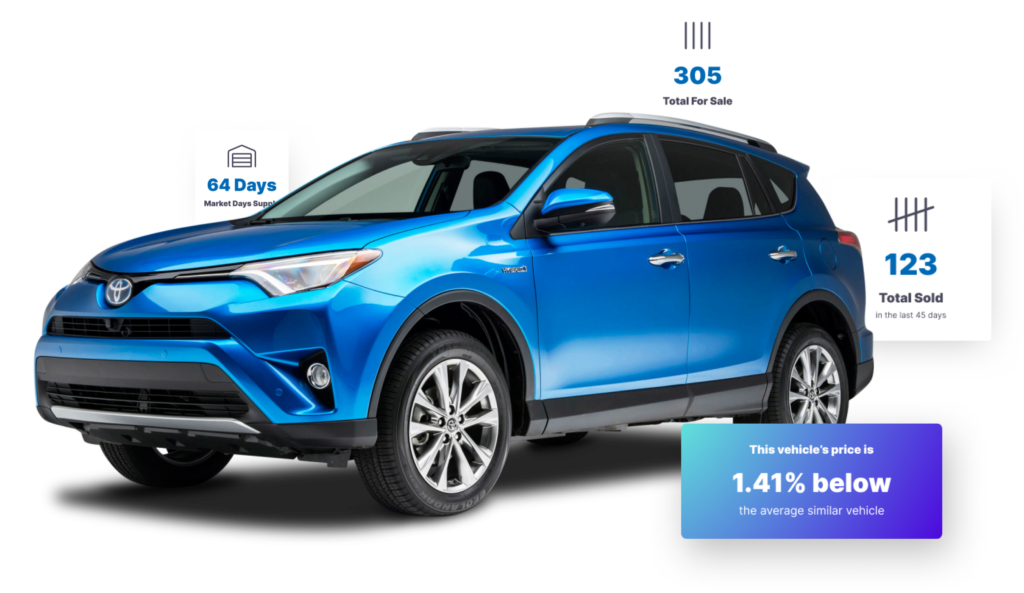
In summary, the used car market is presenting unprecedented challenges for budget-minded buyers. Today’s market conditions are driven by a confluence of factors. These include a shortage of new vehicles due to a chip crisis, a decline in leased vehicles and trade-ins, and an older rental car fleet. These changes have led to a significant increase in the average price of used cars. Affordable options under $20,000 are increasingly rare and more challenging to negotiate.
Before you kick off car shopping, be sure to explore used car deals and inventory in your area with our newest free tool, CarEdge Data Explorer. We’ve also just launched our ultimate deal analysis tool, CarEdge Report, included with every Data and Coach plan. This tool equips you with comprehensive, up-to-date market insights to give you the upper hand in finding and negotiating the best deals on used cars. At CarEdge, we believe in demystifying car buying, once and for all. Knowledge is power!

The art of negotiation is pivotal when it comes to car buying. It’s a game where information is your strongest weapon, and CarEdge is your best ally. Today, we bring you five triumphant tales from the CarEdge Community, each of them a testament to the power of knowledge and the importance of negotiation in the car buying journey. If you’re skeptical about negotiating in today’s car market, these success stories will change your mind!
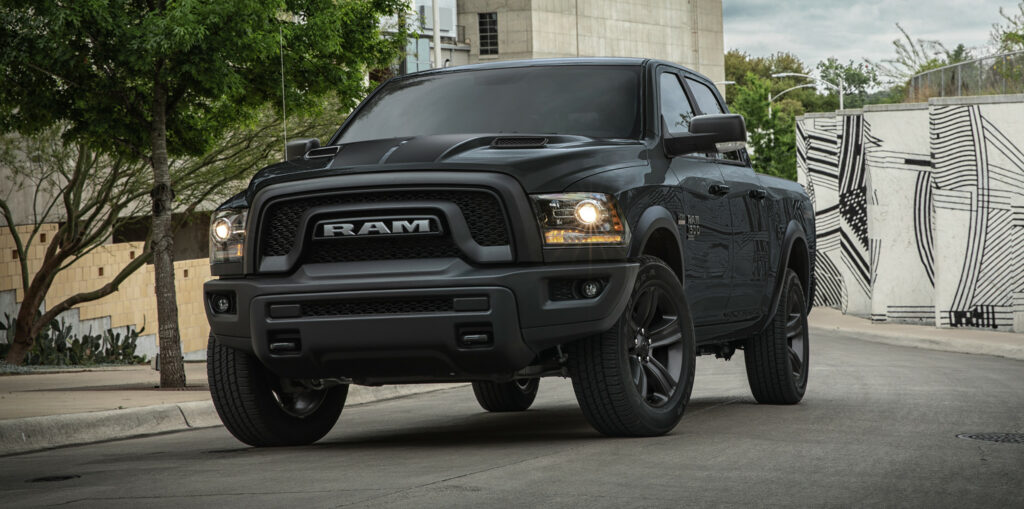
Joey’s story is one of patience, timing, and understanding the market. He had his eye on a new truck and, armed with insights from CarEdge, he waited for just the right moment to make his move.
“I used CarEdge to check for used deals around me,” Joey recalls, “and negotiated a killer deal. The truck had been on the lot for over 70 days and the dealer was motivated. I waited until the last day of the month and negotiated down to my asking price. I also negotiated GAP down almost 50%. You guys are a wealth of information. If it’s taxable it’s negotiable!”
In fact, timing plays into negotiability in a big way. Savvy car buyers know that dealerships often have monthly, quarterly, and yearly sales targets. At the end of these periods, they are more likely to negotiate to hit their goals.
In addition, the length of time a car sits on a dealer’s lot impacts its price. The longer it stays, the more motivated a dealer becomes to sell, offering a ripe opportunity for negotiation. Understanding these dynamics and the concept of supply and demand in the car market can greatly influence the outcome of your negotiation and lead to BIG savings.
Jon’s negotiation journey led him to an unexpected place: a job offer. Working with CarEdge Finance and Insurance Specialist Kimberly Kline, Jon confidently navigated through the dealership’s pitch.
“When I first arrived, the salesman brought out the offer sheet with three different down payment amounts and three different costs per month,” Jon recounts. “He wanted my initials. I declined. The sales manager then came out asking what I wanted. I said that I wasn’t looking at monthly costs but total out-the-door costs.” That simple, informed request set the tone for the rest of the negotiation.
Jon ended up getting the new truck he wanted with an out-the-door price UNDER MSRP. The Sales Manager was so impressed that Jon says he offered to hire him to sell cars. Was it a serious offer? We wouldn’t be surprised if it was with how skillfully Jon stayed in control of his deal!
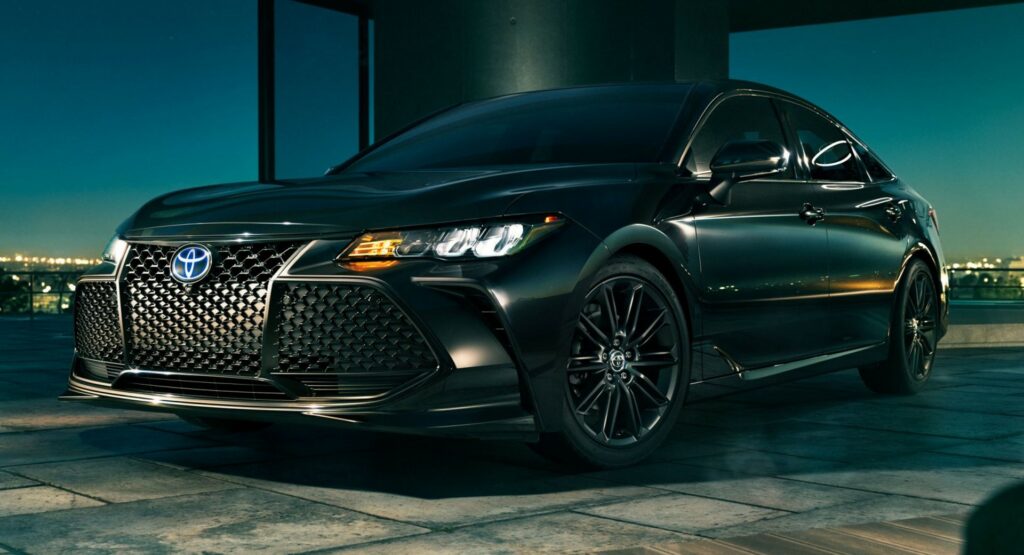
In Tampa, Marcus was eager to get his hands on a low-mileage Toyota Avalon Hybrid. He played hardball with several dealerships until he found one ready to play his game. He secured his dream car for an incredible $8,000 below sticker price and also secured a great deal on his trade-in.
“My advice is don’t fall in love with the car ONLY, also fall in love with the deal! You really have to just stick to it and use what you learn from CarEdge,” Marcus advises. His determination, coupled with CarEdge’s resources, brought him the deal he was after.
Check out Marcus’ full breakdown of his deal here.
Knowledge is power, as Navnit demonstrated. When shopping for a 2023 Mazda 3, the best deal he could initially find was $28,500. After using CarEdge’s tools and Deal School, he was sure he could negotiate a better out-the-door price. His thorough understanding of pricing, taxes, and fees flipped the script, with Navnit explaining to the dealer how THEY could meet HIS terms.
Here’s how he says the deal went down.
Dealer: The best I can do is $27,000 plus taxes and title
Me: No, I am looking for $27,000 out-the-door
Dealer: How is that possible?
Me: Well, you can knock off the $800 in dealer-installed accessories, I don’t need the $700 GAP insurance, I can get deals with a doc fee that is $600 lower than yours, and title and then I know I can get a $1500 discount. If not from you, I could from the 3 others that I have emails from.
Dealer: Let me talk to my manager…. ….. The best I can do is $27,500.
Me: Well thank you but that doesn’t work for me. Tell me you can do 27 and we sign today.
Dealer: Well in that case you need to finance through us.
Me: Well I already have a loan quote from my credit union at 4.75%. can you do better?
Dealer: Hold on….. We can do 4.3%
And just like that, Navnit showed the dealer who was in control. He ended up getting exactly what he wanted, at the price he had in mind.
“I had to be so vigilant,” says Navnit. “I was asking for printed deposit receipts, previewing buyers’ orders, pointing out the rebates they had added and so much more. But the bottom line, buying a car is so damn hard.”
Print Off This Car Buying Cheat Sheet and Take It With You!

Never Pay These Fake Dealer Fees!
In the world of car buying, sometimes an email can save you thousands. Jonathan worked with CarEdge Car Coach Jerry to draft an email to his dealer, transforming the trade-in valuation of his 2015 Crosstrek from $10,290 to $12,000.
Jonathan shared, “The salesperson called me right away the next morning, and said, ‘What number could you do for your car?’ Instinctively I said, ‘How about $12,000?’ and they agreed. If I had it to do over again, I realize there would have been no harm in replying with $12,500 or even $13,000. Big picture, I’m very happy with the deal. Nothing’s perfect, and I take it as a learning experience for next time.”
Jonathan’s email showcased how thorough research and confidence in your offer can lead to significant savings. He credits his success to the knowledge and support provided by CarEdge: “It was great to have someone in my corner. That night I wrote the salesperson an email.”
His story, along with the others, is a testament to how well-informed car buyers can change the dynamic of a negotiation, flipping it in their favor. Check out Jonathan’s full story for more.
See HUNDREDS more success stories at the CarEdge Community
From waiting for the right time to strike, to firmly and confidently advocating for fair prices, these empowered car buyers show that, armed with the right tools and knowledge, you too can come out on top in the car buying game.

Ready to outsmart the dealerships? Download your 100% free car buying cheat sheets today. From negotiating a deal to leasing a car the smart way, it’s all available for instant download. Get your cheat sheets today!
Don’t be afraid to negotiate on your next car purchase. Remember: If it’s taxable, it’s negotiable. Leverage CarEdge Data and our all-new CarEdge Report to understand local market negotiability like never before. Ready to work 1:1 with a car buying expert? CarEdge Coach is the perfect path to big-time savings.